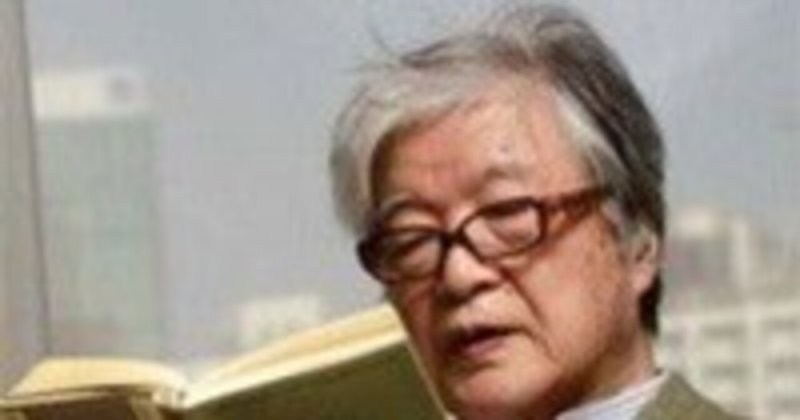
「書物の達人」丸谷才一(まるやさいいち)(英語対訳)5 “A Master of Books” Maruya Saiichi (Japanese-English Translation) 5
「書物の達人」丸谷才一(まるやさいいち)(英語対訳)5
(5)丸谷才一の文体
文芸雑誌などに発表する文章では歴史的仮名遣(かなづか)い(ただし、漢字音については字音仮名遣を採用していない)を用い、その文体を清水義範に『猿蟹合戦とは何か』(『国語入試問題必勝法』に収録、元ネタは『忠臣蔵とは何か』)としてパロディにされたこともあります。丸谷才一は『国語入試問題必勝法』文庫版に解説を寄せており、その中で清水の才能を認めながらも、同時に『猿蟹合戦とは何か』を評価できかねる気持ちを正直に告白し、複雑な心境をうかがわせました。
丸谷才一は旧仮名遣(かなづか)いを用いています。それでいて、軽快な語り口。最初は仮名遣いに戸惑う。旧仮名遣いを使うわりに、旧漢字を使わないのも読み易さに一役買っています。その例を紹介しよう。
会う=会ふ、嫌い=嫌ひ、おかしい=をかしい、あじさい=あぢさい、あっさり=あつさり、嬉しそう=嬉しさう、どうしょうもない=どうしやうもない、あさっていますと(漁っていますと)=あさつてゐますと、まず=まづ、これ以外にも、字体、送り仮名にも丸谷式が存在します。
丸谷才一はなぜ旧仮名遣いをするのか? 『桜もさよならも日本語』「言葉と文字と精神と」に記載があります。最初の小説は旧仮名遣いをしていました。しかし、翻訳もやっていたので、翻訳は新仮名遣いを用いていました。そのうち翻訳以外の時にも新仮名遣いを使うようになったのです。だが、『後鳥羽院』を書いた時、「引用文は歴史的仮名づかひ、地の文は新仮名づかひでゆくといふわづらわしい二本建ては、必然的に両者の比較をわたしに課すことになつたのである。優劣は明かだつた。わたしはその評論を書き上げたのち、ごく自然に新仮名づかひと別れ、国語改革を再検討する意向を固めたのである」(前掲書新潮文庫版一三八頁)。『日本語のために』や『桜もさよならも日本語』から、理由は、現代仮名遣いは旧仮名遣いが備えていた意味の標識性をなくし、語源をわかりにくくさせ、活用の秩序も乱されたという。簡単にいえば旧仮名・歴史的仮名遣いの方が論理的であり、新仮名遣いは例外が多く、論理的にすっきりしないからということか。(例:旧仮名遣い「うな・づく」:うな(頷)をつく(突く)で「うなづく」)
“A Master of Books” Maruya Saiichi (Japanese-English Translation) 5
(5) Maruya Saiichi’s Writing Style
In writings published in literary magazines, historical kana (however, kanazukai is not used for kanji sounds) is used, and the writing style was inspired by Yoshinori Shimizu's "What is Monkey and Crab Gassen?" It was included in ``How to Winning Japanese Language Entrance Exam Questions,'' and it was even parodied as ``What is Chushingura?'' Maruya Saiichi contributed a commentary to the paperback version of ``How to Winning Japanese Entrance Exam Questions,'' in which he acknowledged Shimizu's talent, but at the same time honestly confessed his feeling that he could not evaluate ``What is Monkey and Crab Gassen?'' He revealed that he had mixed feelings.
Maruya Saiichi uses the old kana spelling. Yet, he has a light speaking style. At first, he is confused by the use of kana. Although he uses old kana, he does not use old kanji, which also helps with readability. Let me introduce an example. Meet = meet, dislike = dislike, strange = to ask, hydrangea = hydrangea, simple = assari, looks happy = happy, there's nothing I can do = there's nothing I can do,(Omitted)
In addition to this, there is also the Maruya style for fonts and okurigana.
Why does Maruya Saiichi use old kana? It is described in ``Sakura and Sayonara Mo Nihongo'' and ``Words, Letters, and Spirit.'' His first novel was written in old kana. However, since he was also a translator, he used Shinkana for his translations. Eventually, he started using new kana characters even when not translating. However, when he wrote ``Gotoba-in,'' he said, ``The awkward two-pronged structure in which the quotations are written in historical kana and the local texts are written in new kana inevitably led me to compare the two. The merits and demerits were clear. After I finished writing that review, I quite naturally decided to say goodbye to new kana and reconsider Japanese language reform.'' (Shincho Bunko, cited above) Edition 138 pages). From ``For Japanese'' and ``Sakura mo Sayonara mo Nihongo'', the reason is that modern kana usage has lost the signifier of meaning that old kana usage had, making etymology difficult to understand, and the order of usage has been disrupted. That's what it means. To put it simply, the old kana/historical kana usage is more logical, while the new kana usage has many exceptions and is not logically clear. (Example: Old kana ``Una-duku'': ``Una (nod)'' and ``Una-duku'' (Poke)) (To be continued)
この記事が気に入ったらサポートをしてみませんか?
